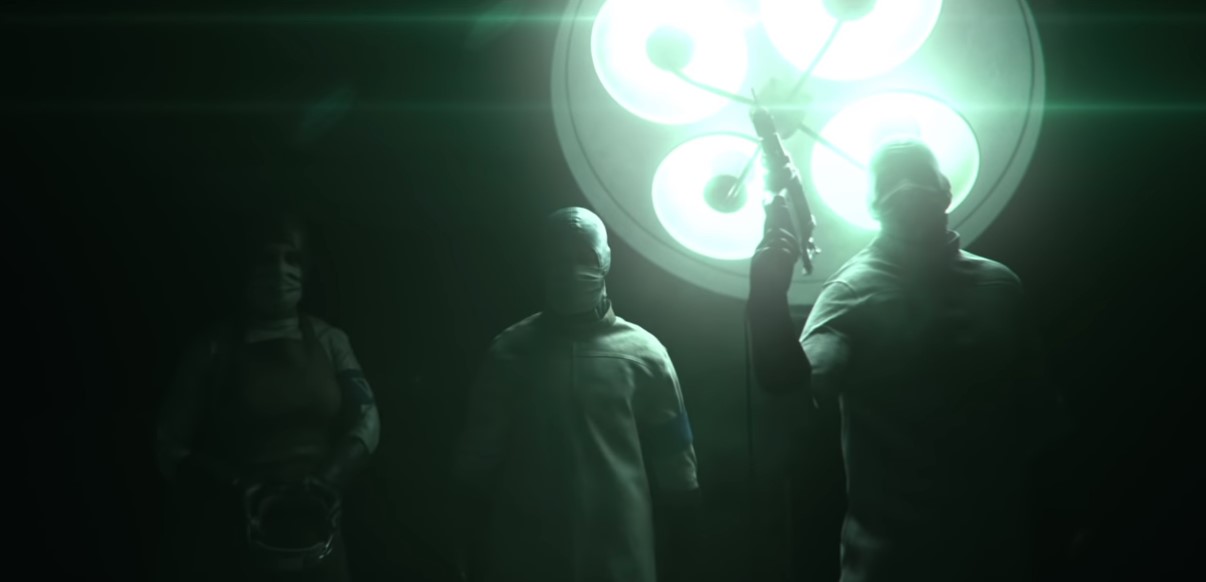CrossCode Review – Playing a game within a game
Retro gaming will always have a place in the modern landscape. For those who grew up during the 8-bit era or even earlier, the appeal of retro type games is no surprise, having experienced them first-hand. Despite the technical limitations of the time, some titles have made their mark in gaming history eventually becoming iconic classics whether it be in terms of gameplay, story, or a combination of both. Enter developer Radical Fish who knows the importance of the past as well and shows it with their release of the PC, and now console, Role-Playing Game CrossCode.
As advertised, CrossCode is a retro inspired Role-Playing Game and it’s very clear from the moment you see it. The bright pixelated art style and graphics, the fixed top view angle, the blocky terrains and towns. All of it will remind you of the NES and SNES era RPGs like the original Final Fantasy and Legend of Zelda.
CrossCode is set in the distant future, where you are a player inside CrossWorlds, a massive MMO Role-Playing Game where the story takes place. Without giving anything away, as the main character Lea, you will embark on a journey of discovery throughout CrossWorlds meeting different characters, exploring everything the game-within-a-game has to offer, and uncovering the mysteries that may very well go beyond the game.
If this all sounds familiar, then you’ve probably seen shows with similar premises of being inside a game. Shows like Sword Art Online and .hack will likely come to mind. Of course story is only half of what CrossCode has to offer.
Learn the ways of the Spheromancer, Grasshopper
The gameplay of CrossCode is, in short, amazing. Having started with RPGs like The Legend of Zelda III, Final Fantasy III/VI, and Chrono Trigger on the SNES, I was expecting something similar, and I did get what I expected and a whole lot more. The initial impression would be that it’s a retro gameplay overhaul.

First off, the combat is really fast paced. It’s an action RPG so no turn-based mechanics anywhere here. As a Spheromancer (one of the classes in CrossWorlds) Lea has access to both close combat and ranged moves. She can get in close doing melee attacks or fire projectiles from a distance. Blocking is relegated to one of your shoulder buttons, there is a short dodge to move away from enemy attacks that you can execute using the PS4 controller’s analog, and the same analog is used to aim your Spheromancer Balls at enemies.
It was all pretty foreign at first on account of analog sticks not being available before, so to use it for aiming and dodging in a retro style RPG was a different feeling, but it certainly fit well and it should be second nature to you within minutes.
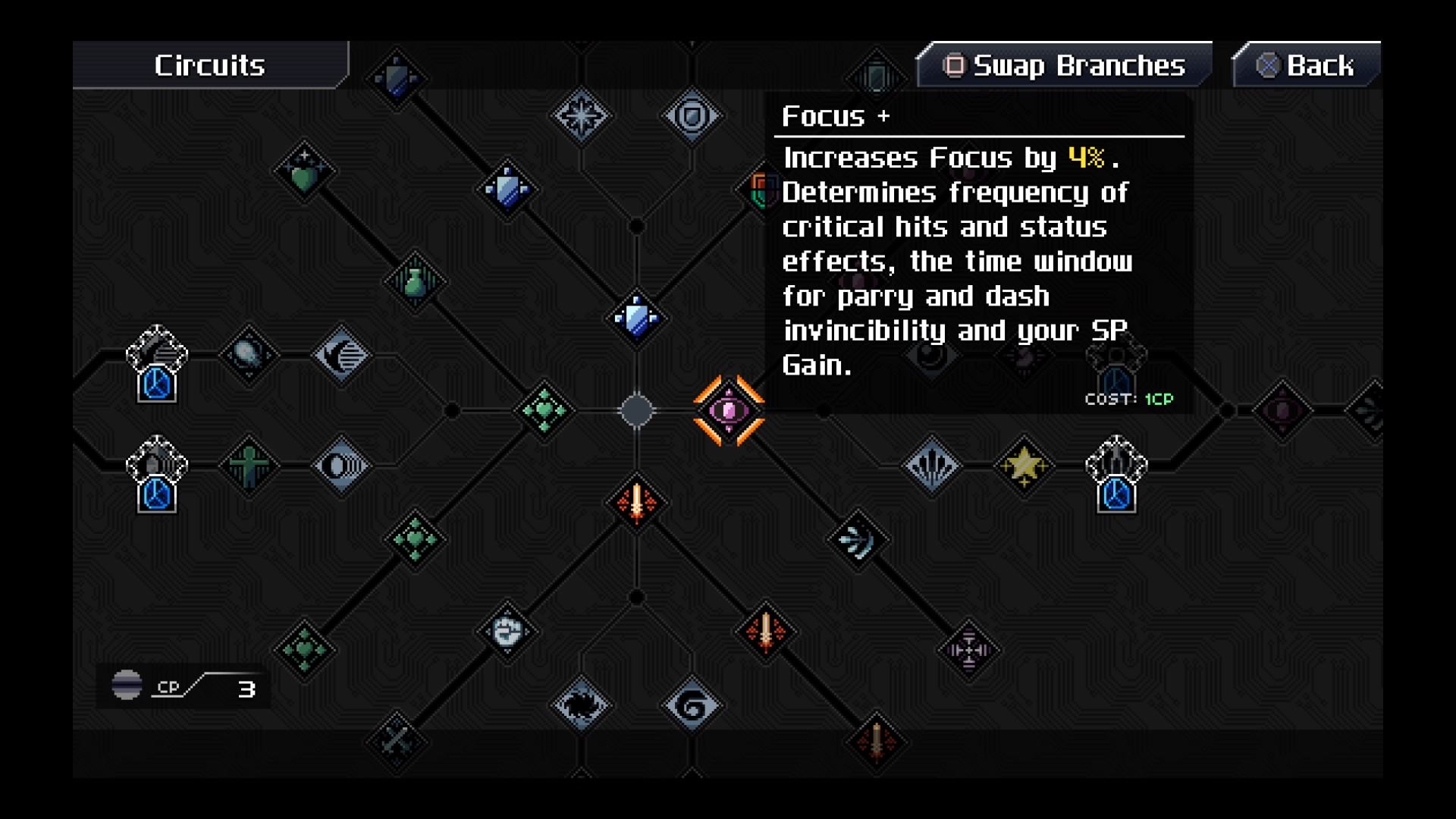
Lea will be able to level up and learn different Arts courtesy of the game’s Circuit System. It wouldn’t be wrong to say this is CrossCode’s version of Final Fantasy X’s Sphere grid because it is, only a bit simpler. You earn Circuit Points (CP) in combat and you use this to move around Lea’s Circuit Grid increasing attributes like HP and melee/ranged damage, and learning different Combat Arts based around Dash, Guard, Melee, and Throw.
The game is fairly generous when it comes to CPs but you will really need to choose wisely in what parameters to level up Lea in. And it shouldn’t come as a surprise that said Circuit Grid will expand to accommodate Elements like Fire and Ice as you progress through the game, since elements are a staple of any RPG after all. It gets pretty deep, so RPG fans will definitely get a kick out of the system.
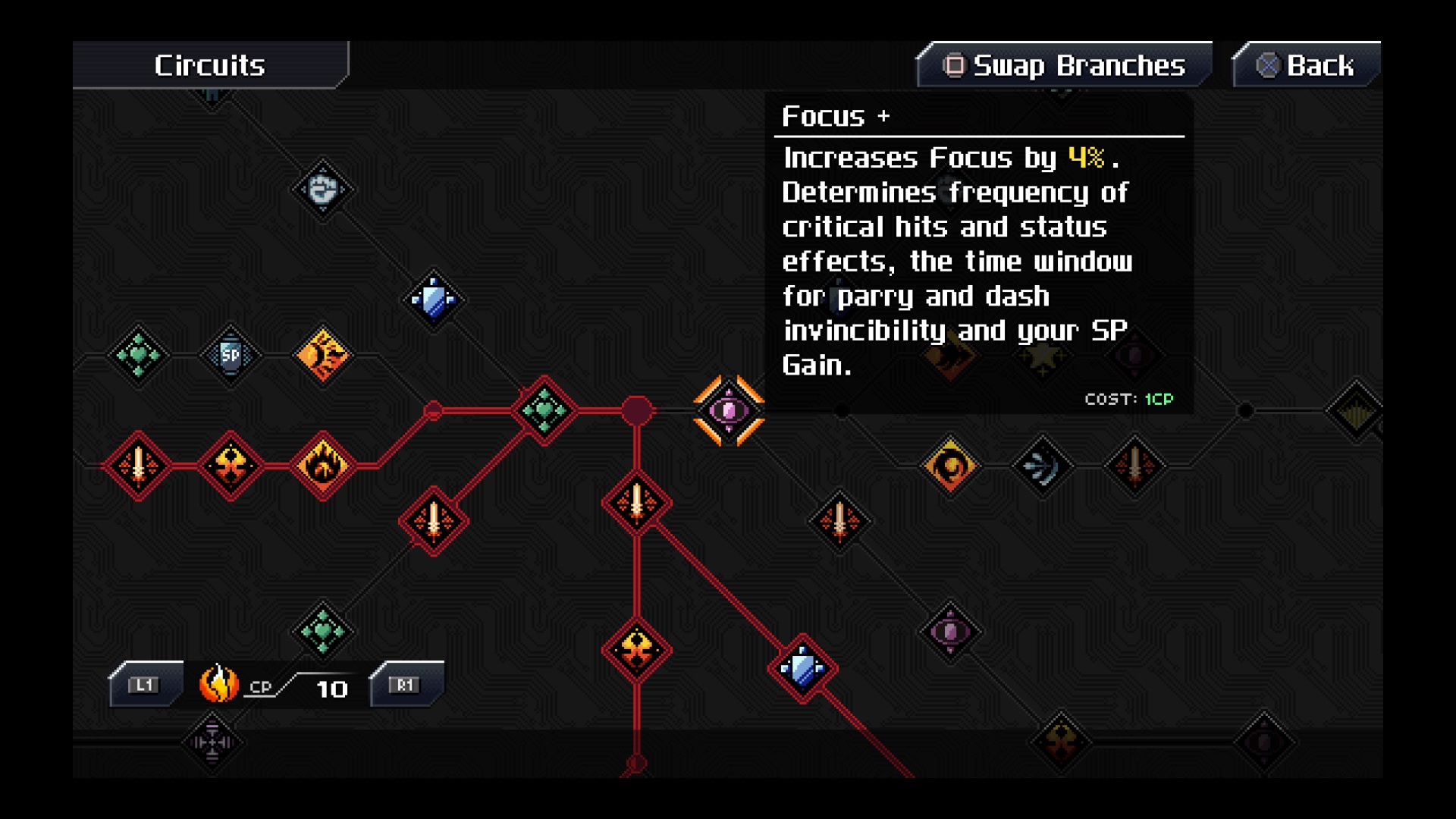
What I did find unique is that when presented with a decision to choose between 2 different Arts in a certain parameter, you’re actually able to swap between either and it won’t cost any CPs to swap. In other words, there is a bit of preference involved. For example in terms of Melee Arts do you prefer the Sphere Saw path which is a powerful attack in one direction or the Spin Cut path which is a less powerful spinning attack that can hit multiple enemies surrounding you?
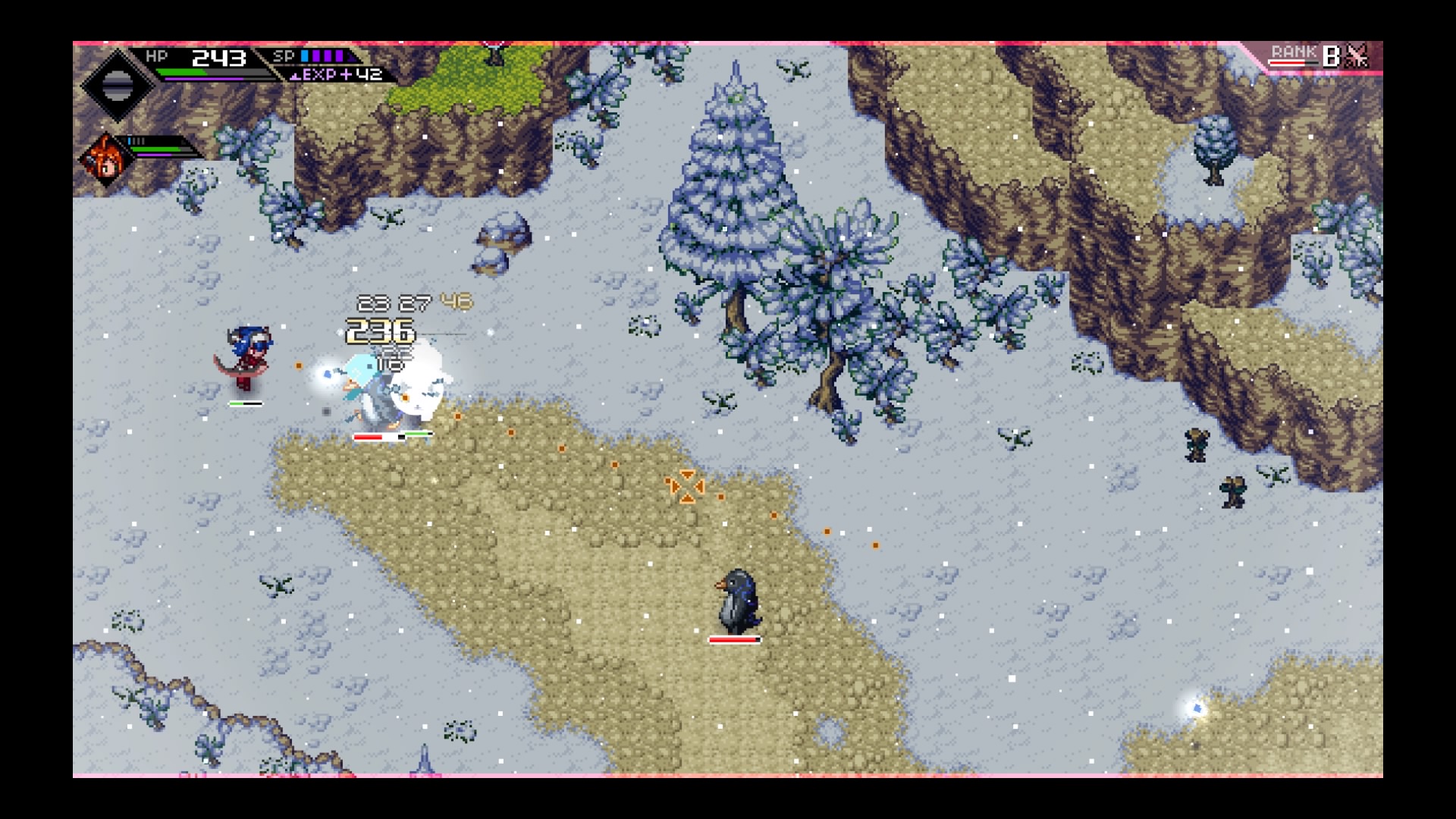
Combat mechanics are fairly deep for something that’s considered retro but nonetheless a welcome feature as it keeps the fighting fast and fun. And you’ll need to get good as the foes and bosses you fight in the game don’t play around. Some fodder can be dispatched with a constant barrage of attacks, easy. Others though are not pushovers, and these are just grunts. Some will have weaknesses and hitting these will cause them to go into a Break state and it’s only here that you can deal massive damage.

Bosses you fight will also test you similarly, only these bad boys hit way harder and need a lot of trial and error to beat. It’s still a matter of finding patterns to memorize, weaknesses to exploit, and finding the right tools for the job , or in this case the right Arts to use. Not to mention fast reflexes and timing are a must. And each boss you fight just gets progressively more challenging.

To compliment your stats, in true RPG fashion, stores are available in the towns of the different areas in CrossWorlds where you can buy items, armor, and weapons. Not only that, but there are also trading posts where you can exchange goods. And these trading posts sometimes have some useful gear you don’t see in the stores so you’ll be really motivated to trade.

There is also a sense of aggressiveness the game encourages because in combat, there is a rank system where your rank increases relative to the number of enemies you defeat. And the higher the rank, the better rewards you get. We say aggressive because after every fight, there is a cooldown timer represented by blue borders that will return you to the lowest rank when they disappear. So to stay in the coveted S Rank, you got to keep on the offensive constantly finding enemies on the map to beat.

We should also mention that one of CrossCode’s really great features is your HP regenerates after every fight if you opt to take a breather instead of chasing after that S Rank. The other is that majority of enemies in the field will NOT attack you unless you attack them first. It made exploring a tad bit easier if you’re not in the mood to fight. Not all though will be just as passive and there will still be enemies that will attack you first. These two were really convenient features along with the ability to save the game anywhere. And that’s not all. The game also offers fast travel options provided you found the teleportation areas in the map.

Don’t think you’ll be doing all this alone too. CrossCode may be a single-player game but you will be able to partner up with certain characters you meet to help you in combat. You AI allies are fairly competent and you’re able to customize their behavior according to their targets and aggressiveness. If anything, it’s a little disappointing that Lea is your only playable character. Spheromancer isn’t the only class in CrossWorlds and trying out others like Emilie’s punch specializing Pentafist class would’ve been interesting.
So basically in CrossCode, combat is all about getting strong and being smart. And speaking of smart, your intellect and wits won’t be used just to dispatch your enemies.
Is this game CrossWorlds or PuzzleWorlds?

It really wouldn’t be too far off to call CrossCode a puzzle game disguised as an RPG, though at its core it’s definitely a Role-Playing Game and you do normally find puzzles in RPGs. In the case of CrossCode, the number of puzzles you will find in this game is just astounding, and definitely challenging.

Now puzzles to advance inside dungeons are a given, and they are definitely an exercise for the brain that will require almost everything you can think of whether it be timing, memorization, or trial and error. What can be a bit overwhelming if you’re a completionist is that similar puzzles can be found just travelling around CrossWorlds.
There is no jump button, but walking towards certain terrains will make Lea auto jump, whether it be a short elevation or jumping short distances to other platforms. The moment I realized this could happen I already knew I was in for a whole heap of puzzles as throughout CrossWorld’s different areas there are certain items that seem out of reach at first until you realize that exploring and finding paths you can jump to will let you reach otherwise unreachable areas.

Not only chests with items, but exploring and finding places you can jump to will also net you time saving shortcuts. And you’ll also need to think outside the box here as finding said hidden paths will sometimes involve you moving in between different parts of a map. Not to mention with a few new upgrades later, newer paths will open.
In other words, throughout CrossCode you’ll be constantly presented, may we even say bombarded, with puzzles to solve and though majority are just optional, for those who can’t ignore a challenge it’ll mean almost not running out of things to do. Albeit it can be a bit exhausting. And remember, you can’t avoid fighting enemies as you need to level up and get stronger too.
I am… whatever these quests ask me to be

Towns are also your source of side quests in CrossCode. Sure you can find certain NPCs with “!” their heads as you go around but the hub in the different towns should help you find where they are.
These will net you pretty neat rewards and experience points needed to get stronger. NPCs will have all heaps of things for you to do. If you don’t mind those usual quests of go do this, find that, go here, defeat this enemy, deliver x item to this place, etc. then maybe the tediousness and kind of boring grind won’t really get to you.
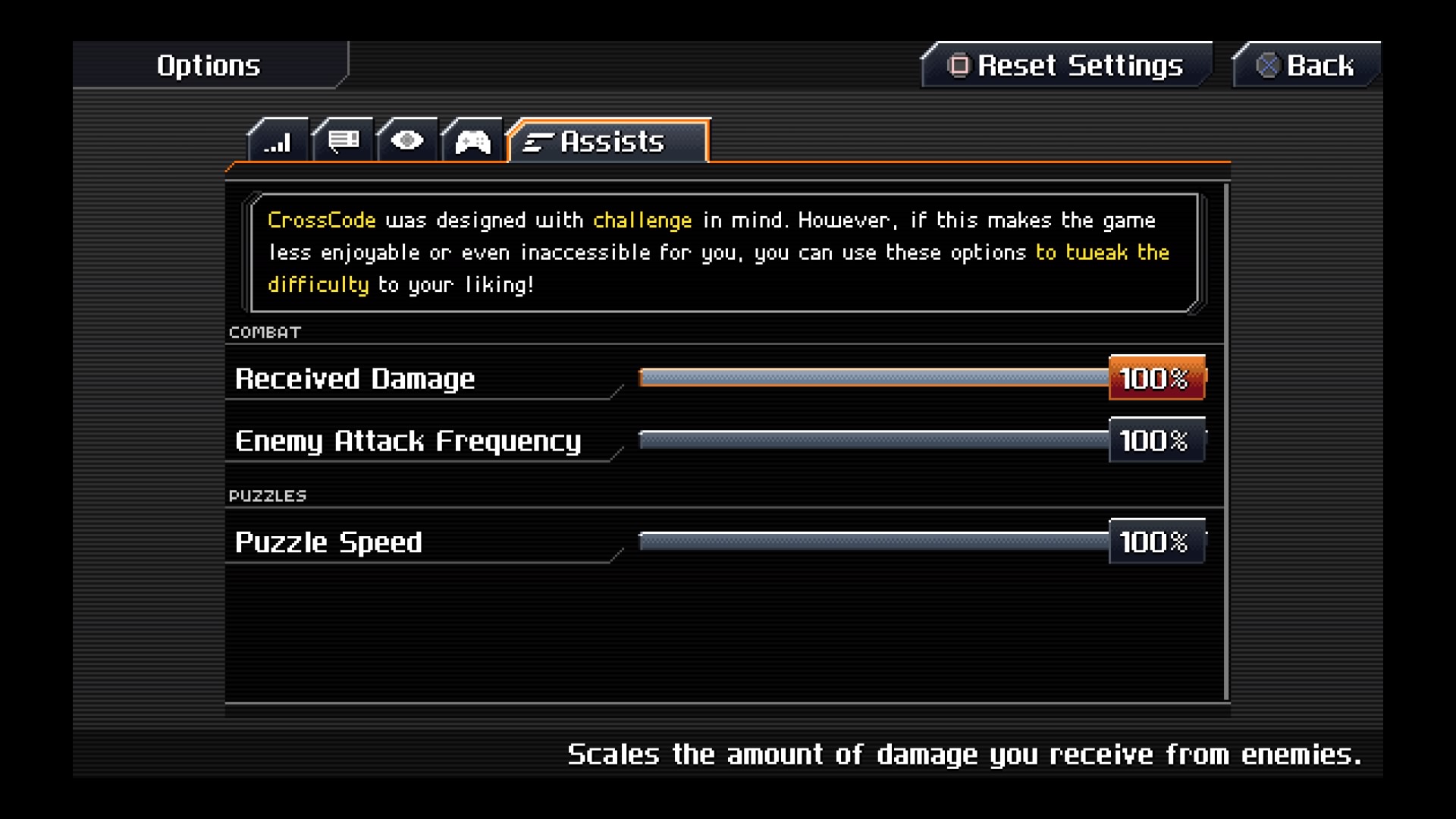
Now fortunately, if some of these mechanics overwhelm you, CrossCode offers accessibility options where you can adjust the game’s puzzle and combat difficulty…to a certain extent. CrossCode is definitely not an easy game, and it’s so-called “default” difficulty setting offers puzzles and enemies that can maybe cause you to tear your hair off. So there’s no harm in making the game a bit more bearable, like making some puzzle timings easier for example. If challenge is your thing though, then leaving the game in its default setting is the way to go. And there’s really nothing like the feeling of solving a difficult conundrum on your own.
Next Level Retro

CrossCode definitely gets points in presentation as it shows what a next-generation retro game can look like. Sure everything is clearly pixelated, there’s lots of repeat animations, and it’s easy to spot similar NPC sprites everywhere, but that’s the point of a retro RPG and simply put Radical Fish went beyond expectations. It’s especially a nice touch that you’ll see other NPC CrossWorlds players moving around towns and battle areas that it gives off the illusion of a constantly active online player community.

Character sprites and massive bosses move smoothly in-game and the portraits during conversations are very expressive. You’ll know this is true when you see all the faces Lea makes. It’s also neat how the developers try to give characters you meet a bit of a personality through the writing. And to think this is retro so no voice-overs.

You can clearly see Lea’s friend Emilie, for example, is French from all the French words in her dialogue that you can almost hear her accent. Not to mention hear her real world talk. CrossWorld is still an MMORPG after all, though a highly advanced futuristic one at that, so the players you meet are still real people with mundane real life issues.
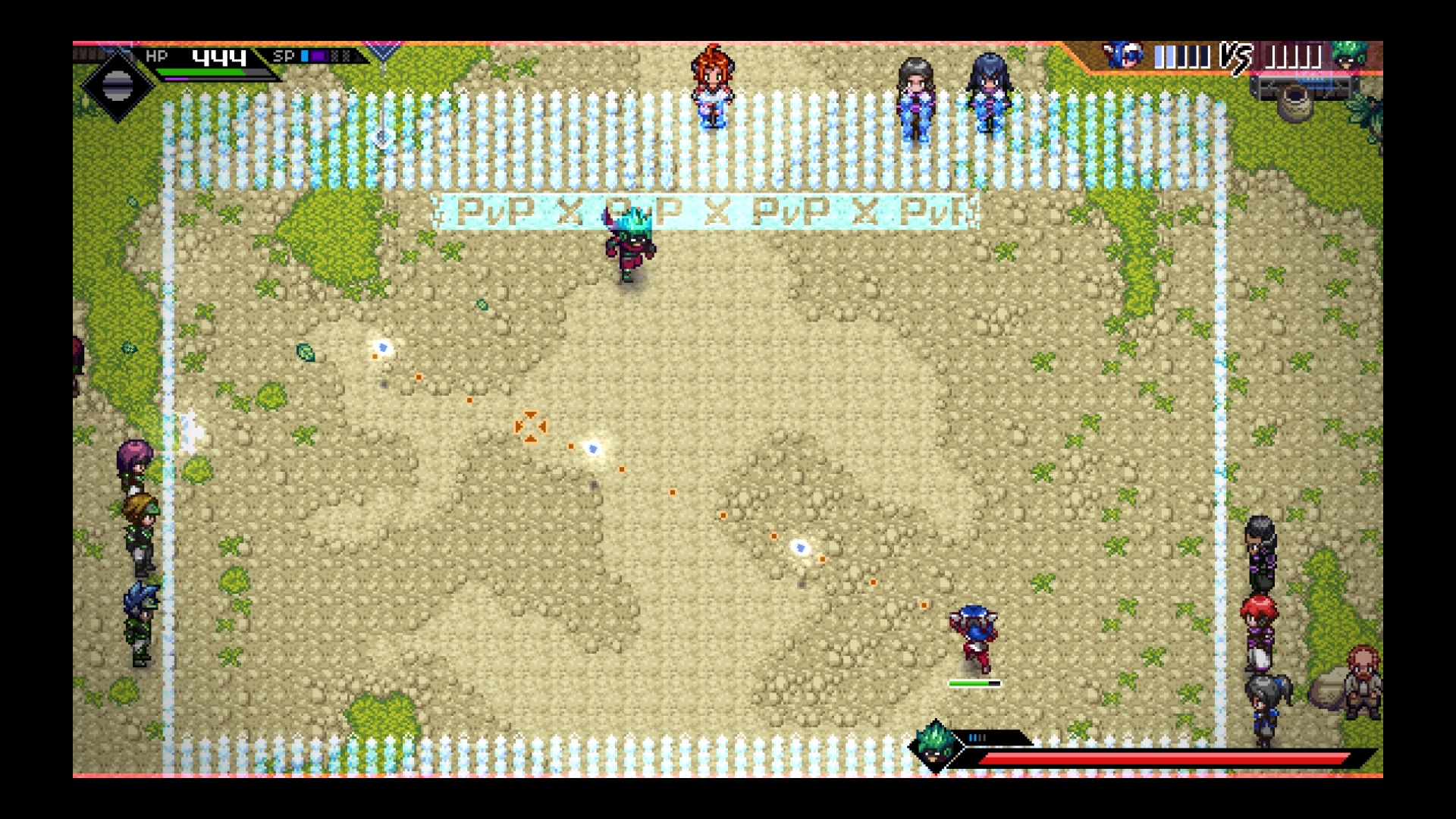
There’s also an annoying loudmouth you meet early on that counts as a mini boss fight that you don’t need to win to progress. But let’s just say that when you meet this certain character, you will WANT to grind to oblivion and beat said character to the ground for the sheer satisfaction of it. You can’t help it. In any online RPG you’ll meet all sorts of player types.

Music in CrossCode is also something worth noting. Set in a distant future, you can definitely feel it from the music in this game when some of the game’s combat music starts up. There’s even a different track from when you reach the highest rank in combat and its fast pace really sets the tone for wanting to find more enemies to defeat. Not all tracks stand out though. Some are just the normal variety like town BGMs, but they do the job of setting the mood.
This all feels a bit too familiar…
Now with everything good going for it, CrossCode isn’t exactly the pinnacle of gaming. The story can be considered nothing new especially if you’ve seen other trapped-in-a-game type shows, so you might be able to predict somewhat how the plot goes. That shouldn’t stop you though from pressing on and finding out for yourself.

The characters too were fine but didn’t really feel all too memorable. It felt like checking boxes of what character archetypes did the developers want to put in CrossCode. The dialogue though was at times funny. They just don’t stick in your mind for too long. If anything, what you’ll likely remember are the faces Lea makes.

Some of the side quests too don’t really feel worth doing. They can get really tedious and can become the boring kind of grind, especially when some quest objectives tend to repeat. We did say only some as certain quests do pit you against strong foes so challenge seekers may find something worthwhile. Either way, the bottom line is at least you get items and experience points for your trouble. It may very well the only reason to tackle these side quests, save for maybe the drive to complete everything.
What we liked:
- Smooth classic retro graphics
- Deep combat
- Challenging puzzles
- Accessibility options for different players
What we didn’t like:
- Average and predictable story
- Generic characters
- Tedious and repetitive side quests
- Only one playable character class
Verdict: Buy it!

So in the end despite some gripes with story, characters, and quests, CrossCode is still actually worth getting on account of what else it has to offer players. We want to be clear that the story and characters aren’t exactly bad, they’re just not exactly groundbreaking. But that shouldn’t stop you from experiencing CrossCode as the combat and puzzles make it worth the journey. And we have to mention this is available for $19.99 or roughly PHP995 so for a game heavy on gameplay and a beautiful retro look to boot, that’s really not a bad deal all things considered.
CrossCode is available via Digital download but for physical boxed version collectors, it is available also from the Inin Games Website.
CrossCode was reviewed on a PlayStation 4 Pro via a code provided by the publishers.


